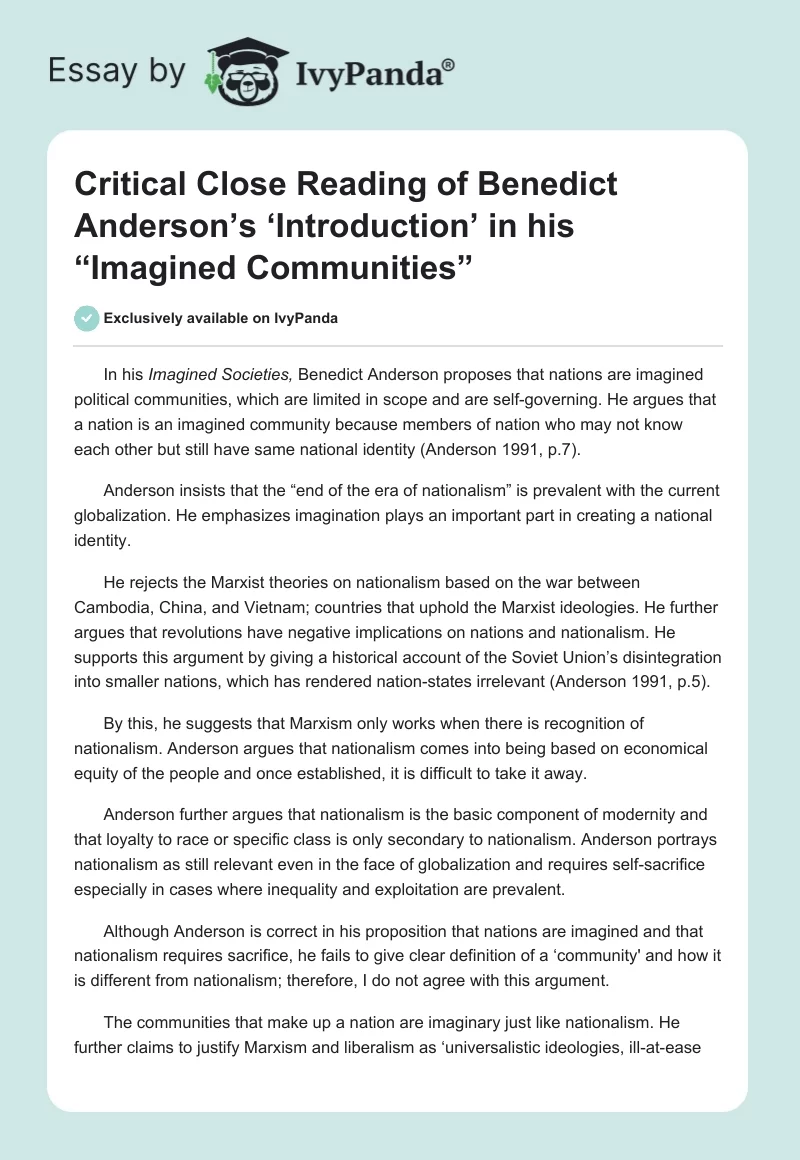In his Imagined Societies, Benedict Anderson proposes that nations are imagined political communities, which are limited in scope and are self-governing. He argues that a nation is an imagined community because members of nation who may not know each other but still have same national identity (Anderson 1991, p.7).
Anderson insists that the “end of the era of nationalism” is prevalent with the current globalization. He emphasizes imagination plays an important part in creating a national identity.
He rejects the Marxist theories on nationalism based on the war between Cambodia, China, and Vietnam; countries that uphold the Marxist ideologies. He further argues that revolutions have negative implications on nations and nationalism. He supports this argument by giving a historical account of the Soviet Union’s disintegration into smaller nations, which has rendered nation-states irrelevant (Anderson 1991, p.5).
By this, he suggests that Marxism only works when there is recognition of nationalism. Anderson argues that nationalism comes into being based on economical equity of the people and once established, it is difficult to take it away.
Anderson further argues that nationalism is the basic component of modernity and that loyalty to race or specific class is only secondary to nationalism. Anderson portrays nationalism as still relevant even in the face of globalization and requires self-sacrifice especially in cases where inequality and exploitation are prevalent.
Although Anderson is correct in his proposition that nations are imagined and that nationalism requires sacrifice, he fails to give clear definition of a ‘community’ and how it is different from nationalism; therefore, I do not agree with this argument.
The communities that make up a nation are imaginary just like nationalism. He further claims to justify Marxism and liberalism as ‘universalistic ideologies, ill-at-ease with nationalism’ thus suggesting that the ideologies support nationalism but states that both these ideologies do not involve cultural aspects of nationalism.
According to Anderson “nationality… nation-ness, as well as nationalism, are cultural artifacts of a particular kind” (1991, p.6). This argument is correct because communities always identify themselves with culture and thus the nationalism must appreciate culture.
Anderson’s claim that a nation is imagined, does not mean that a nation is unreal or that nations exist somewhere in dreamland. He instead proposes that nationalism is a process brought about by common culture and interests among people that in the end pulls them together as they strive for a common goal.
This means that political and cultural factors contribute to nationalism as people ‘imagine’ that their cultural beliefs and attitudes are common. Therefore, the people remain aware that their personal opinions are national. Anderson further argues that nations represent political entities with physical boundaries rather than entities that are limitless.
Anderson proposes that the concept of the nation is recent and it came into being the late-eighteenth century to take over the regimes that were dependent on monarchies or religious governance. By this, he suggests that within the precepts of nationalism, sovereignty is important. A nation therefore must conceptualize sovereignty and rule over its national citizens.
However, the national rule should be over limited population demographics and within limited territorial boundaries. He further argues that patriotism is a national duty of all the citizens of a nation and that the sacrifice for the sake of nationalism is important. In times of war, citizens forget their class boundaries or ethnicity in their united struggle for national victory and survival.
Reference
Anderson, B., 1991. Imagined Communities: Reflections on the Origin and Spread of Nationalism. New York: Verso.


